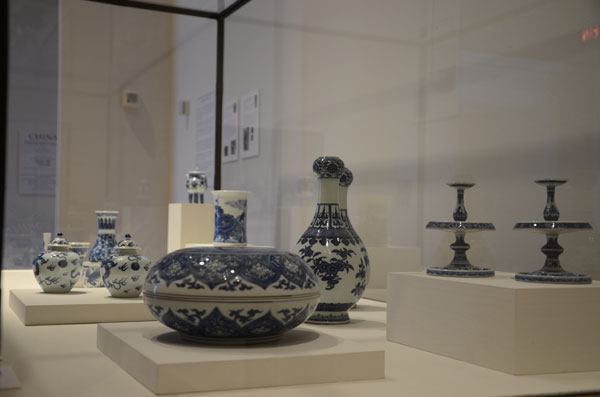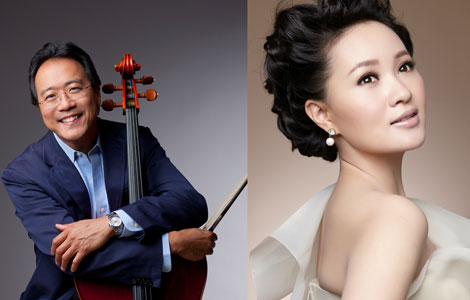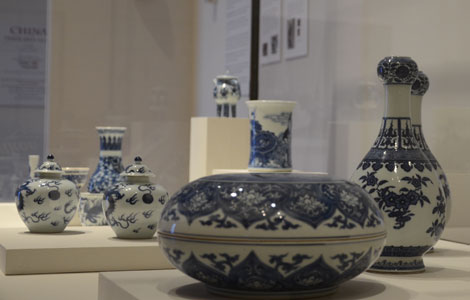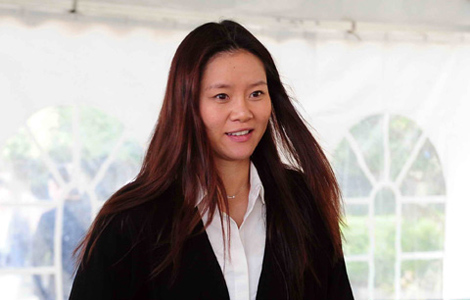Long Island collectors display Chinese art then and now
Updated: 2015-01-20 06:12
By NIU YUE in New York(China Daily USA)
|
||||||||
 |
|
The blue-and-white porcelain pieces, made in the 17th-19th century and collected by the Frick family, are shown for the first time in public as a group at Nassau County Museum of Art in the Long Island, New York. LU HUIQUAN / FOR CHINA DAILY |
One of the largest and most important suburban art museums in the United States, located in the heart of Long Island's fabled Gold Coast, is exhibiting Chinese ancient and contemporary art from collectors on Long Island.
The exhibition China Then and Now Nassau County Museum of Art (NCMA) is open until March 8 at the museum on the former Frick estate, 20 miles east of New York City in Roslyn Harbor, Long Island.
The exhibition starts with Buddhist sculpture made of stone and marble from the 6th century. The sculptures were made during a time when civil wars pushed people to Buddhism for spiritual asylum and were not recognized as fine art by the American mainstream until the 20th century.
The exhibition, which took three years to plan, continues with blue-and-white porcelain from the Ming and Qing dynasties and ends with ink paintings by Liu Dan, a contemporary Chinese painter.
"Our guiding idea in the exhibition has been to present works that best characterize facets of Chinese art," said Amy Poster, curator of the exhibition.
"The show is highly selective," said Poster. While the "Then" part was presented by Buddhist art from the 4th-8th century, and the blue-and-white porcelain represent works around the 17t -19th centuries, the "Now" part is presented by Liu Dan's art works, which combine Western styles and traditional Chinese ink painting techniques.
Long Island collectors have some of the most dazzling Chinese art, said Poster. Affluent residents in the area traveled around the world and bought Chinese artworks. "When you travel, you get excited about certain things, and those blue-and-white [porcelains] became fashionable," said Laura Lynch, NCMA's director of education.
In 1919 Henry Clay Frick, co-founder of US Steel Corporation, purchased the Georgian mansion that now houses the museum as a wedding gift for his son, Childs Frick, a fan of Chinese art. The museum used to be Frick's residence, and some of the house's decorations were imported from China. He also had an extensive collection of Chinese porcelains that were used both for artistic displays and for daily uses. The collection is being shown for the first time in a group.
"American collectors, museums and scholars have long appreciated Chinese culture and the arts of China as one of the world's great artistic cultures," said Poster.
But it has become illegal to sell Chinese antiques for profit. And as Chinese government regulation tightens, it is increasingly difficult for foreign collectors to acquire Chinese antiques. American collectors, therefore, started to shift their attention toward contemporary artists.
In a separate but related exhibition - Long Island Collects the Arts of China at NCMA - more modern Chinese artworks are shown. Beyond religious or aesthetic pursuits, these Chinese artists touched social topics. For example, one of Chinese installation artist and textile designer Lin Tianmiao's Focus series puts the artist's own digital photograph on canvas with thread, which reflects the restrictions women are facing in China.
A workshop on Chinese art will also be available from Feb 17 to 19, where parents could create artworks with children after a tour of the museum. "It's about getting out of your room, getting out of your computer and talking about things, thinking creatively. Each problem solving is getting through an art medium," Lynch said.
Lu Huiquan in New York contributed to this story.
- Chinese naval escort fleet visits Germany
- At least 4 killed in clashes in Congo
- UN condemns escalating attacks by Boko Haram
- Israel steps up security for possible Syria airstrike
- Australian police raised terrorism threat to 'high'
- EU to appeal against court ruling that Hamas be removed from terrorist list: official

 7 things you may not know about Major Cold
7 things you may not know about Major Cold
 After the American dream breaks
After the American dream breaks
 300 libraries for China's countryside
300 libraries for China's countryside
 New York Philharmonic to celebrate Lunar New Year
New York Philharmonic to celebrate Lunar New Year
 Long Island collectors display Chinese art then and now
Long Island collectors display Chinese art then and now
 China's Li Na expecting first baby
China's Li Na expecting first baby
 Bank, Rockets help out school
Bank, Rockets help out school
 Top 10 trading partners of the Chinese mainland in 2014
Top 10 trading partners of the Chinese mainland in 2014
Most Viewed
Editor's Picks

|

|

|

|

|

|
Today's Top News
Opening round of Iran sanctions fight kicks off in Senate
Drive against terrorism in Xinjiang shows result
Xiaomi feeling 'phabulous' about new phablet
Economic growth edges to 24-year low of 7.4%
China: Pet-food products removal not a judgment
SAT reform could send more Chinese to ACT
300 libraries for China's countryside
Happy Chinese New Year for some Bay Area businesses
US Weekly

|

|







